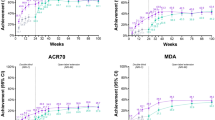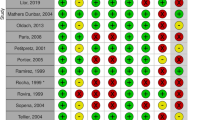Abstract
The aim of this study was to validate a novel technique that predicts stopping of disease-modifying anti-rheumatic drugs (DMARDs) and biologic agents (BA) from the Veterans Affairs (VA) database and compare infection risks of rheumatoid arthritis patients who stopped versus continued DMARDs/BA perioperatively. We identified 6,024 patients on 1 DMARD or BA in the perioperative period between 1999 and 2009. Time gap between medication stop date and the next start date predicted drug stoppage (X). Time gap between surgery date and stop date predicted whether stoppage was before surgery (Y). Chart review from Houston VA was used for validation. ROC analyses were performed on chart review data to obtain X and Y cutoffs. The primary endpoints were wound infections and other infections within 30 days. ROC analyses found X ≥ 33 (AUC = 0.954) and Y ≥ −11 (AUC = 0.846). Risk of postoperative infections was not different when stopping and continuing DMARDs/BA preoperatively. Stopping BA after surgery was associated with higher odds of postoperative wound (OR 14.15, 95 % CI 1.76–113.76) and general infection (OR 9.2, 95 % CI 1.99–42.60) compared to not stopping. Stopping DMARDs after surgery was associated with increased risk of postoperative general infection (OR 1.84, 95 % CI 1.07–3.16) compared with not stopping. There was positive association between stopping DMARDs after surgery and postoperative wound infection but failed to achieve statistical significance (OR 1.67, 95 % CI 0.96–2.91). There was no significant difference in postoperative infection risk when stopping or continuing DMARD/BA. Our new validated method can be utilized in the VA and other databases to predict drug stoppage.



Similar content being viewed by others
References
Listing J, Strangfeld A, Kary S, Rau R, von Hinueber U, Stoyanova-Scholz M, Gromnica-Ihle E, Antoni C, Herzer P, Kekow J, Schneider M, Zink A (2005) Infections in patients with rheumatoid arthritis treated with biologic agents. Arthritis Rheum 52(11):3403–3412. doi:10.1002/art.21386
Grennan DM, Gray J, Loudon J, Fear S (2001) Methotrexate and early postoperative complications in patients with rheumatoid arthritis undergoing elective orthopaedic surgery. Ann Rheum Dis 60(3):214–217
Pieringer H, Danninger K, Tzaribachev N, Bohler N, Pohanka E, Herold M (2013) Patients with arthritis undergoing surgery: how should we manage tumour necrosis factor blocking agents perioperatively?-A systematic literature review. Yonsei Med J 54(1):253–257
Pieringer H, Stuby U, Biesenbach G (2008) The place of methotrexate perioperatively in elective orthopedic surgeries in patients with rheumatoid arthritis. Clin Rheumatol 27(10):1217–1220
Ng B, Aslam F, Petersen NJ, Yu HJ, Suarez-Almazor ME (2012) Identification of rheumatoid arthritis patients using an administrative database: a Veterans Affairs study. Arthritis Care Res 64(10):1490–1496
Thomas SL, Edwards CJ, Smeeth L, Cooper C, Hall AJ (2008) How accurate are diagnoses for rheumatoid arthritis and juvenile idiopathic arthritis in the general practice research database? Arthritis Rheum 59(9):1314–1321
The Society for Hospital Epidemiology of America, The Association for Practitioners in Infection Control, The Centers for Disease Control, The Surgical Infection Society (1992) Consensus paper on the surveillance of surgical wound infections. Infect Control Hosp Epidemiol 13:599–605
Charlson ME, Pompei P, Ales KL, MacKenzie CR (1987) A new method of classifying prognostic comorbidity in longitudinal studies: development and validation. J Chronic Dis 40(5):373–383
Deyo RA, Cherkin DC, Ciol MA (1992) Adapting a clinical comorbidity index for use with ICD-9-CM administrative databases. J Clin Epidemiol 45(6):613–619
Radner H, Smolen JS, Aletaha D (2011) Comorbidity affects all domains of physical function and quality of life in patients with rheumatoid arthritis. Rheumatology 50(2):381–388
Anstead GM (1998) Steroids, retinoids, and wound healing. Adv Wound Care 11(6):277–285
Karukonda SR, Flynn TC, Boh EE, McBurney EI, Russo GG, Millikan LE (2000) The effects of drugs on wound healing–part II. Specific classes of drugs and their effect on healing wounds. Int J Dermatol 39(5):321–333
Oxlund H, Fogdestam I, Viidik A (1979) The influence of cortisol on wound healing of the skin and distant connective tissue response. Surg Gynecol Obstet 148(6):876–880
Rhen T, Cidlowski JA (2005) Antiinflammatory action of glucocorticoids–new mechanisms for old drugs. N Engl J Med 353(16):1711–1723
den Broeder AA, Creemers MC, Fransen J, de Jong E, de Rooij DJ, Wymenga A, de Waal-Malefijt M, van den Hoogen FH (2007) Risk factors for surgical site infections and other complications in elective surgery in patients with rheumatoid arthritis with special attention for anti-tumor necrosis factor: a large retrospective study. J Rheumatol 34(4):689–695
Kawakami K, Ikari K, Kawamura K, Tsukahara S, Iwamoto T, Yano K, Sakuma Y, Tokita A, Momohara S (2010) Complications and features after joint surgery in rheumatoid arthritis patients treated with tumour necrosis factor-alpha blockers: perioperative interruption of tumour necrosis factor-alpha blockers decreases complications? Rheumatology 49(2):341–347
Ruyssen-Witrand A, Gossec L, Salliot C, Luc M, Duclos M, Guignard S, Dougados M (2007) Complication rates of 127 surgical procedures performed in rheumatic patients receiving tumor necrosis factor alpha blockers. Clin Exp Rheumatol 25(3):430–436
Shergy WJ, Phillips RM, Hunt RE, Hernandez J (2005) Infliximab and its impact on surgical outcomes in patients with rheumatoid arthritis. EULAR Meet Abstr 64(Suppl 3):1511
Carpenter MT, West SG, Vogelgesang SA, Casey Jones DE (1996) Postoperative joint infections in rheumatoid arthritis patients on methotrexate therapy. Orthopedics 19(3):207–210
Jain A, Witbreuk M, Ball C, Nanchahal J (2002) Influence of steroids and methotrexate on wound complications after elective rheumatoid hand and wrist surgery. J Hand Surg Am 27(3):449–455
Kasdan ML, June L (1993) Postoperative results of rheumatoid arthritis patients on methotrexate at the time of reconstructive surgery of the hand. Orthopedics 16(11):1233–1235
Perhala RS, Wilke WS, Clough JD, Segal AM (1991) Local infectious complications following large joint replacement in rheumatoid arthritis patients treated with methotrexate versus those not treated with methotrexate. Arthritis Rheum 34(2):146–152
Sany J, Anaya JM, Canovas F, Combe B, Jorgensen C, Saker S, Thaury MN, Gavroy JP (1993) Influence of methotrexate on the frequency of postoperative infectious complications in patients with rheumatoid arthritis. J Rheumatol 20(7):1129–1132
Boyko EJ, Koepsell TD, Gaziano JM, Horner RD, Feussner JR (2000) US Department of Veterans Affairs medical care system as a resource to epidemiologists. Am J Epidemiol 151(3):307–314
Hudson M, Suissa S (2010) Avoiding common pitfalls in the analysis of observational studies of new treatments for rheumatoid arthritis. Arthritis Care Res 62(6):805–810
Acknowledgments
The research reported here was supported by the Department of Veteran Affairs, Veterans Health Administration, Health Services Research and Development Service, (VA.SCV.1010./000-00.B_N). This work was also partly supported by the Veterans Affairs Health Services Research and Development Service Houston Center of Excellence (HFP90-020). Dr. Bernard Ng held a South Central VA Health Care Network Research Pilot Grant Award and was a consultant to UCB Pharmaceuticals. The rest of the authors have no conflicts of interest to declare. The funding sources had no role in the study design, conduct and analysis or in the decision to submit the manuscript for publication.
Conflict of interest
None.
Author information
Authors and Affiliations
Corresponding author
Electronic supplementary material
Below is the link to the electronic supplementary material.
Rights and permissions
About this article
Cite this article
Abou Zahr, Z., Spiegelman, A., Cantu, M. et al. Perioperative use of anti-rheumatic agents does not increase early postoperative infection risks: a Veteran Affairs’ administrative database study. Rheumatol Int 35, 265–272 (2015). https://doi.org/10.1007/s00296-014-3121-0
Received:
Accepted:
Published:
Issue Date:
DOI: https://doi.org/10.1007/s00296-014-3121-0




